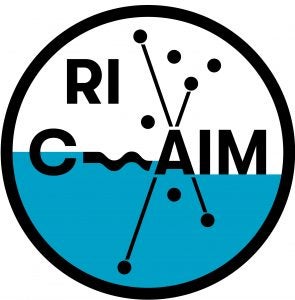
RISD grad student develops logo for new RI C-AIM initiative
Ellen Christensen, a student at the Rhode Island School of Design, first scribbled sketches in her notebook. A new initiative through the Rhode Island NSF EPSCoR program needed a new logo. What would this new logo look like? What message should it convey?
“They were terrible,” laughs Christensen, a Richmond, Calif., native who will defend her MFA in Graphic Design this May. “We really wanted this logo to work for different types of people and institutions, and there were many different ways I would sketch that in the beginning.”
The new initiative is the Rhode Island Consortium for Coastal Ecology Assessment, Innovation and Modeling (RI C-AIM), a collaborative initiative developing a new scientific infrastructure to measure and respond to the changing waters of the bay.
Neal Overstrom, director of RISD’s Edna Lawrence Nature Lab, had first charged Christensen with the design, and over a two-month process they both deliberated with team members about the logo’s details.
“Simplicity is often difficult to achieve, with a logo being a distillation of many complex ideas and elements to create a unified, visual identity,” says Overstrom, who serves as a co-principal investigator on the RI C-AIM project, about the logo design process.
“It was us as a four-person group talking in the original stages,” adds Christensen of the collaboration, which included RISD EPSCoR Coordinator Lucia Monge and Dora Mugerwa, Operations & Engagement Coordinator at The Nature Lab. “We met every week, going through all these different iterations,” she explains. “There were two main themes; the ideas of connection and [Narragansett] Bay.”
The project is tapping into the expertise of scientists, designers, artists and students from eight higher education institutions across Rhode Island, from mathematicians and chemical engineers to graduates like Christensen, who is utilizing her creative sensibilities to give the RI-C-AIM logo more than a passing glance from the public.
“We didn’t want it to feel really old-fashioned, but something fresh,” she says. “We wanted the logo to work for a variety of different people and institutions.”
to feel really old-fashioned, but something fresh,” she says. “We wanted the logo to work for a variety of different people and institutions.”
The logo depicts a circle with the letters ‘RI-C-AIM’ contained within. A stylized constellation sits behind the letters, symbolizing scientific collaboration among the eight institutions. A half-blue background represents the program’s shared research setting of Narragansett Bay.
“One thing that is interesting about the logo is the way the A is the networking target, getting at the idea of ‘aiming’,” Christensen notes. “It’s kind of like X marks the spot.”
And that spot is turning Rhode Island into a ‘center of excellence’ for assessing, predicting and responding to the bay’s changing physical ecosystems.
“Although this was just one collaborative project, it underscores the ways in which the perspectives of artists and designers bring complementary modes of inquiry to scientific research through studio-based studies,” says Overstrom.
Students like Christensen, who previously served as a communications graduate assistant for RI EPSCoR during the program’s last award, are also gaining valuable experience in disciplines from graphic design to oceanography, honing their skills to pursue future career success.
“I think the professors at RISD are brilliant,” she says. “We spend five hours a day talking about the nuances of every little detail. We are all going into the world observing, being really careful about what we see.”
The Rhode Island School of Design is one of eight higher education institutions participating in RI-C-AIM, the annual symposium for which will take place on April 9 at the University of Rhode Island.
The Rhode Island Consortium for Coastal Ecology Assessment, Innovation and Modeling is a five-year, $19 million initiative funded through the RI NSF EPSCoR program seeking to develop a technological infrastructure to predict and respond to the changing interactions between chemicals and lifeforms in the waters of Narragansett Bay.
For more information, visit https://web.uri.edu/rinsfepscor.

 RI NSF EPSCoR is supported in part by the U.S. National Science Foundation under EPSCoR Cooperative Agreements #OIA-2433276 and in part by the RI Commerce Corporation via the Science and Technology Advisory Committee [STAC]. Any opinions, findings, conclusions, or recommendations expressed in this material are those of the author(s) and do not necessarily reflect the views of the U.S. National Science Foundation, the RI Commerce Corporation, STAC, our partners or our collaborators.
RI NSF EPSCoR is supported in part by the U.S. National Science Foundation under EPSCoR Cooperative Agreements #OIA-2433276 and in part by the RI Commerce Corporation via the Science and Technology Advisory Committee [STAC]. Any opinions, findings, conclusions, or recommendations expressed in this material are those of the author(s) and do not necessarily reflect the views of the U.S. National Science Foundation, the RI Commerce Corporation, STAC, our partners or our collaborators.